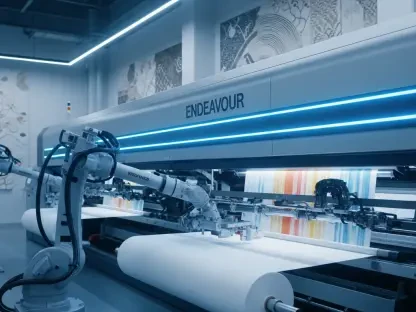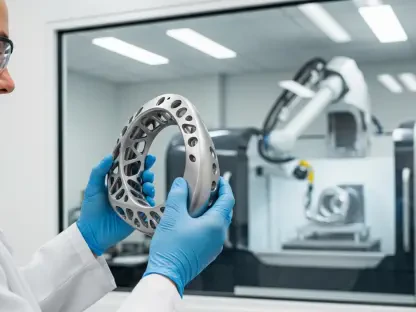Kwame Zaire is a distinguished leader in the field of manufacturing, focusing on the intersection of electronics, equipment, and production management. Known for his insights into predictive maintenance and quality and safety enhancement, Kwame is at the forefront of driving technological transformation in pharma labs. In this discussion, we explore the essential elements and challenges of next-gen pharma labs, touching on digitalization, workforce dynamics, and the critical integration of AI.
Can you explain the concept of next-gen pharma labs and why they are important in today’s pharma industry?
Next-gen pharma labs are designed to meet the increased demand for faster and more accurate drug discovery processes. They integrate advanced technologies, such as digitalization and AI, to streamline operations and improve outcomes. In the current pharmaceutical landscape, these labs are crucial because they significantly enhance efficiency and the ability to respond swiftly to global health challenges.
What are some of the global health challenges that are pushing pharma organizations to innovate lab structures?
Pharma organizations are driven by the need to tackle pandemics, address antibiotic resistance, and provide personalized medicine. These challenges necessitate a rethinking of lab structures to support rapid innovation and adaptability in research and production processes.
What role does digitalization play in modernizing pharma labs?
Digitalization transforms how labs operate by replacing manual, analog processes with automated, data-driven workflows. This shift reduces errors, enhances data accuracy, and speeds up research cycles, allowing for more robust and precise drug development.
How is artificial intelligence (AI) being integrated into next-gen pharma labs?
AI plays a central role by enabling predictive analysis and automating routine tasks. It supports researchers by providing insights drawn from large datasets, helping to predict outcomes and streamline processes, ultimately accelerating the drug discovery timeline.
How critical is the skill set and culture of the workforce in implementing next-gen pharma labs?
The workforce’s skill set and culture are pivotal. A digitally savvy team is essential to leverage the full potential of next-gen technologies. Cultivating a culture of continuous learning and adaptability ensures that personnel can effectively implement and sustain lab transformations.
Our survey indicates that transformation takes two to five years for most organizations. What are the main factors contributing to this time frame?
The primary factors include the scale of technological integration, workforce adaptation, and the overhaul of existing processes. Such comprehensive transformation requires time to design, pilot, and refine strategies, ensuring long-term sustainability and effectiveness.
What are some of the biggest challenges in data management and technology that organizations face in this transformation?
Organizations often grapple with integrating disparate data systems, ensuring data security, and maintaining data integrity across platforms. Overcoming these challenges is critical to harnessing the full potential of advanced data analytics in pharma labs.
Can you describe the essential elements needed to enable next-gen labs?
Key elements include robust digital infrastructure, seamless systems integration, and energy-efficient lab architecture. Additionally, leveraging intelligent data capture and implementing digital workflows are essential for enhancing lab efficiency and productivity.
How important is systems integration in the development of next-gen labs?
Systems integration is vital, allowing different platforms and technologies to communicate effectively. It eliminates data silos, ensuring a smooth flow of information, which is crucial for the coherent functioning of advanced lab technologies and processes.
What considerations should be made in terms of lab architecture to ensure sustainability and energy efficiency?
Sustainable lab architecture involves selecting materials and designs that reduce energy consumption and environmental impact. Incorporating renewable energy sources and minimizing waste are critical considerations for achieving long-term sustainability.
How can intelligent data capture and analytics help in the drug discovery process?
Intelligent data capture reduces errors and enhances the precision of data collected from experiments. When combined with analytics, it aids in identifying viable drug candidates faster, terminating less promising ones early, and refining subsequent experiments efficiently.
What are some current analog communication issues in labs, and how can digital workflows address these problems?
Analog systems are prone to errors from data entry and miscommunication. Digital workflows streamline communication, reduce transcription errors, and ensure data consistency, fostering a more effective and error-free environment.
How do innovative technologies like AI and machine learning contribute to the acceleration of discovery?
AI and machine learning enable faster processing of complex datasets and predictive modeling of experimental outcomes. This accelerates hypothesis testing and decision-making, significantly speeding up the drug discovery process.
When gearing up for transformation, why is early involvement of end users, such as scientists and lab technicians, crucial?
Involving end users early ensures that the new systems meet practical needs and facilitate ease of use. Their input is essential for tailoring solutions that enhance work efficiency and ensuring the successful adoption of new technologies.
What are the benefits of developing transformation projects incrementally with an agile approach?
An agile approach allows organizations to adapt to changes and learn from each iteration. Incremental development enables quick wins, maintaining stakeholder engagement and reducing risks associated with large-scale transformations.
Can you explain the ‘fail-fast’ mentality and how it aids the adoption process among scientists and technicians?
The ‘fail-fast’ approach encourages rapid experimentation and learning from failures. This mindset reduces fear of trying new methods, fostering innovation and adaptability, which are essential for seamless adoption of new technologies.
Why is it important to safeguard investments during the transformation of labs?
Protecting investments ensures resources aren’t wasted and maximizes ROI. Effective safeguarding strategies allow labs to adjust programs without losing critical funding stability, securing their path to sustained innovation and improvement.
How can lab practitioners contribute to IT projects in the context of lab transformations?
Their practical insights help inform IT solutions that align with research goals. Involving lab practitioners ensures systems are user-friendly and enhance rather than hinder scientific workflows, contributing to better project outcomes.
What specific roles can generative AI and large language models play in Research and Development (R&D)?
These technologies can streamline data interpretation, automate tedious documentation tasks, and enhance predictive modeling in experiments. They provide critical insights and save time, allowing researchers to focus on more creative and strategic tasks.
How can AI and natural language processing models be used for tasks such as CMC documentation, product quality reports, and lab experiment analysis?
AI and NLP automate the extraction and analysis of data, ensuring comprehensive and accurate documentation and reporting. They facilitate quicker analysis of experimental results, supporting greater accuracy and efficiency in the development process.
What might be the consequences for leaders who do not prepare their businesses for the changes that next-gen labs entail?
Failing to prepare can lead to missed opportunities for innovation, reduced competitiveness, and inefficiencies that hinder scientific progress. Organizations may struggle to keep pace with industry standards, ultimately impacting their long-term success.
What is your forecast for the development of next-gen labs?
I anticipate a rapid evolution towards fully integrated, AI-powered labs that not only enhance speed and precision but also foster an environment of sustainable innovation. As technology advances, the pace of drug discovery and development is likely to accelerate, leading to groundbreaking medical solutions.









